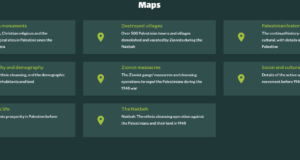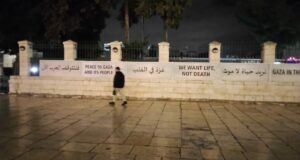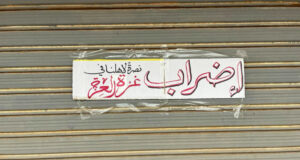by Lena
Nablus has the historical reputation of being at the heart of Palestinian resistance. The Israeli government apparently claims that this is still the case and the conditions of the occupation have been harsher here than elsewhere.
After the start of the second Intifada in September 2000 residents of Nablus were forbidden to leave the city and non-residents were forbidden from entering. People who needed to pass the checkpoints could only do so in ambulances and even then they would be delayed for extended periods of time.
About a year ago people under the age of 45 were allowed out of the city and this was then reduced to 35, then 25, until two weeks ago when people of all ages have been allowed to cross the checkpoints on foot. Vehicle access is almost non-existent.
Within the area of the surrounding checkpoints the population of Nablus is about 200,000, which includes four refugee camps and six or seven villages. A number of other villages lie outside the checkpoints, but these are regularly cut off from the city.
Curfews in the villages and closures at the checkpoints have rendered it exceptionally difficult for the villages to provide Nablus with the food upon which it once depended. Although these days it is easier for people to move around, there are still big problems getting agricultural produce in, and apparently the situation now is that a significant proportion of fresh fruit and vegetables are being supplied by the settlements. It is perhaps difficult to appreciate just how messed up this is unless you have a bit of an idea about the general situation here.
In 2001 a huge trench was built between Nablus and four neighbouring villages which was then filled with sewage from the settlement of Elon Mora. Thereafter all movement between the city and the villages was funnelled through two crossing points – one also houses an occasional checkpoint and the other is just a pipe crossing over the open sewage: only recommended for people with good balance.
Settlements and military bases are on top of most of the hills around the valley in which Nablus is situated. The settlements are distinctive by their location and the uniformity of the buildings – red rooftops on white square buildings. An extensive network of roads serves the settlements, which are out of bounds to the Palestinian population and carve up the entire West Bank and Gaza strip.
Once the settlements are established they expand and spread “like a cancer”, as a Palestinian friend once described to me. As well as the area of land that they cover, the surrounding area is also out of bounds to Palestinians, regardless of whether they own land there or not. In one place that I visited the last time I was here this was a radius of about five kilometres from the settlement. If Palestinians enter this area they risk being shot at, either by the army or by the armed inhabitants of the settlements. These people are scary: In many settlements they form a civilian militia made up of people who are fanatical religious fundamentalists. The settlements are paramilitary communities.
Things in Nablus are much less dramatic now than when I last stayed here in November 2002 – I haven’t seen a tank yet (what have they done with them? Lent them to the United States for use in Iraq? Perhaps they were on loan in the first place). Buildings have been rebuilt, the roadblocks – huge piles of rubble which would appear overnight turning busy streets into dead ends – have been cleared and all the shops are open. Curfews in the city haven’t been imposed for extended periods this year; sometimes they were enforced for months on end. In one village near Nablus they have spent one year out of the last five under curfew, if you add up all the days. The last major military incursion into Nablus was in September last year, although there are small scale incursions almost every night, particularly in the refugee camps and the old city.
The psychological impact of the occupation has been acute and the economic impact is still crippling. Since September 2000 per capita income in the West Bank has decreased from $1600 to $700, and this does not take into account the escalation in prices bought on by scarcity and the risks involved with transporting produce. In Gaza the figures are even worse: from $1400 to between $300 and $400 – about level with countries in Sub-Saharan Africa that are in the throes of conflict.
I have been staying in Balata refugee camp, the largest in the West Bank in population terms with about 35,000 people, but an area which is only 800 meters by 500. Refugee camps in Palestine are long-established places which house people who were evicted from their land in what is now called Israel, either in 1948 or 1967. Yesterday I met a woman who is over 80 years old who still lives in the house which the United Nations built for her when she arrived in 1948.
Meeting people in the camp is like being taken on a tour of human tragedy. We spent an hour or two yesterday in a family home and as they bought out coffee, juice, biscuits and fruit we listened to the stories of the people in the room. One woman had lost a son who was killed by the military a year before, whilst her other son was in jail serving a sentence of sixty years.
A woman of about 25 had herself spent two years in prison, and had lost her hearing in one ear as a result of one of the beatings she received. She described the conditions of solitary confinement and the actions of the prison guards who, sometimes high on drugs, subjected them to humiliating treatment.
Next to me was a woman who smiled and joked with me as she fed her two year old child on her lap. When she was seven months pregnant a soldier had thrown a sound bomb between her legs, and the pressure of the explosion meant that she had had to have an emergency caesarean. The child was born two months premature and will probably never be able to walk. One side of his brain is not working properly and half of his body sags, devoid of any strength. He had operations on both of his lungs, and he sat wheezing on her lap as she gestured towards the child and her heart. Her husband translated: “Her heart is bleeding for this one”, he said.
Throughout the period of the ‘ceasefire’ the military have continued to enter Balata camp at night-time, shooting down the streets at the young boys throwing stones, who never agreed to stop their resistance. To begin with, the fighters did not retaliate: they wanted to get their lives back, to stop running down the narrow alleyways of the camp, to spend a night with their families and not expect the next bullet to be headed towards them. As far as they understood, the ceasefire would mean that they were no longer ‘Wanted’ and could continue their lives as ordinary people. However, the army killed two people from the camp about a month ago and a couple of weeks ago they came in and arrested six people. As a result a young fighter from the camp ran through the streets, shouting at people to end the ceasefire. That night, when the army came into the camp, a big clash ensued – the first in months. No-one was killed then, but the next day Special Forces – a branch of the army – came into the camp undercover, lured the man who had shouted in the street out of his house and shot him. He was taken to Huwara military base where he bleed to death and his body was then returned to the camp and dumped in the street for medics to collect.
Last night one of the three international women in the flat where I am staying had a phone call at 9.45: Special Forces were in the camp. We put down our bowls of half-eaten food and rushed out to meet the local Palestinian ISM co-ordinator and an international who is working on some projects in Balata. They were in the middle of a crowd of young boys, and explained to us that two boys had been taken by special forces and then released. Our friends had walked down the road near the building that special forces were in, and shots had been fired from it in their direction, possibly to scare them off. It was unclear where Special Forces were and what they were planning on doing. Before long an army jeep pulled up on the opposite side of the main street to where we were standing. The boys with us started shouting and ran to grab stones from the floor as a second jeep pulled up nearby. We heard that there was also army at the graveyard at the other end of the camp. A phone call told us that there were fighters behind us and that they intended to resist the incursion. In this situation there is nothing that we can do – the last place for us to be is between armed Palestinians and the Israeli military. We formed a line and began retreating down the street at right angles to the main road, which is one of the three main streets of the camp. We held our arms out to indicate that we were unarmed and tried to look as ‘international’ as possible.
Back at the flat a series of phone calls updated us on the situation – the army were stationed at all entrances of the camp; in one place there were about 10 jeeps. We agreed that if someone was injured and the medics arrived and wanted us to be there we would leave the flat and accompany them. There were also Special Forces in the camp, a fact that worried the long term international that I was with because it seemed to indicate that one or more assassinations were about to take place. Possibly they were after one of the teenagers that we had seen earlier that day, walking through the camp with their automatic weapons over their chest (which one?). I saw nothing like this the last time I was here. We spent a couple of hours trying to distinguish between different noises and working out where the gunfire was coming from. Some of it sounded pretty close and a loud explosion happened nearby. Eventually we went to bed, not knowing what to expect this morning.
Thankfully, no-one was killed or injured last night and no houses occupied. We learnt that settlers had come to pray (??????) at a place called Joseph’s Tomb, which is across the road from the camp in Balata village, between the camp and Nablus itself, near where we initially saw the army jeeps last night. This evidently entailed a large military operation and explains why they surrounded the camp, preventing anybody from leaving or seeing what was happening.
 International Solidarity Movement Nonviolence. Justice. Freedom.
International Solidarity Movement Nonviolence. Justice. Freedom.


